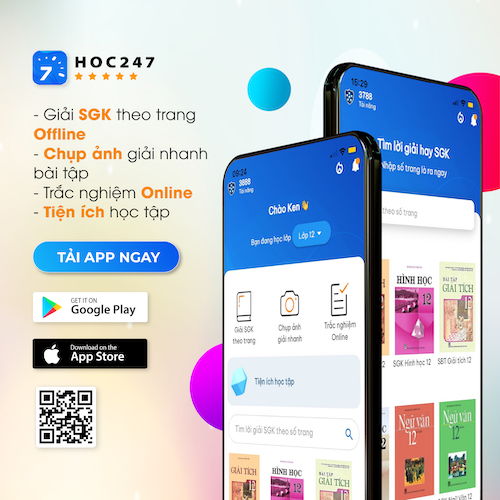Unit 4 lớp 11: Caring For Those In Need - Reading
Kĩ năng đọc hiểu rất quan trọng, để giúp các em tự tin hơn trong kĩ năng này, phần Reading dưới đây hướng dẫn các em xây dựng từ vựng, đọc hiểu, thông qua các dạng bài tập khác nhau, các em hiểu về chủ đề "Chăm sóc những người cần". Mời các em cùng tham khảo!
Mục lục nội dung
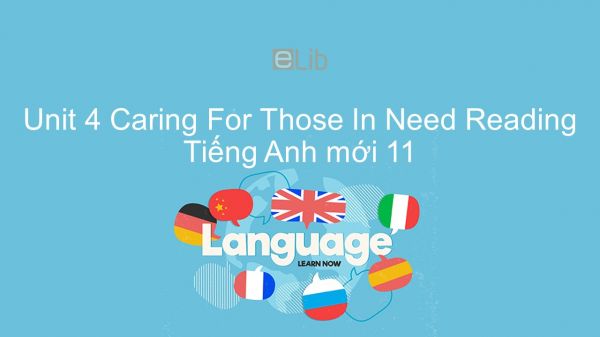
1. Task 1 Unit 4 lớp 11 Reading
Look at these symbols. They are used to indicate acccss for people with disabilities. Write who each symbol is for. (Hãy nhìn những biểu tượng này. Chúng được dùng để chỉ những người khuyết tật. Hãy viết ra xem mỗi biểu tượng đó dành cho người nào.)
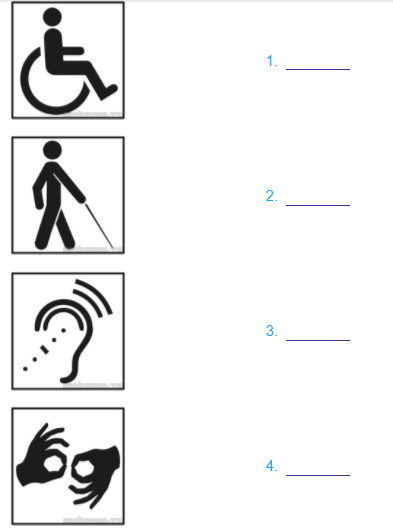
Guide to answer
1. People with mobility impairments/ disabilities (Những người khuyết tật về vận động.)
2. People with visual impairments/ disabilities (Những người bị khiếm thị)
3. People with hearing impairments/ disabilities (Những người khiếm thính)
4. People with speech impairments / disabilities (Những người khuyết tật về khả năng nói)
2. Task 2 Unit 4 lớp 11 Reading
Match each of the words with its meaning. Use a dictionary , if necessary. (Hãy ghép mỗi từ theo đúng nghĩa của nó. Sử dụng từ điển nếu cần.)
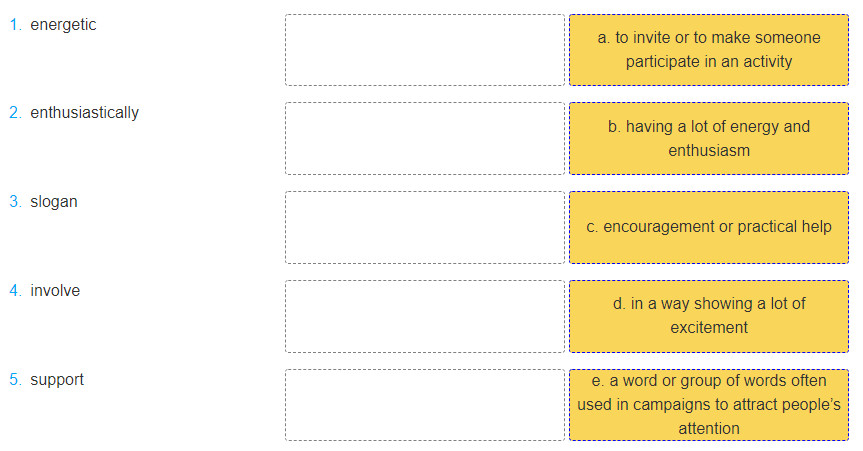
Guide to answer
1.b 2.d 3.e 4.a 5.c
Tạm dịch:
1. năng lượng - có nhiều năng lượng và sự nhiệt tình
2. nhiệt tình - trong một cách cho thấy rất nhiều hứng thú
3. phương châm - một nhóm các từ thường được sử dụng trong các chiến dịch để thu hút sự chú ý của mọi người.
4. liên quan - mời hoặc để ai đó tham gia vào một hoạt động
5. ủng hộ - sự khuyến khích hoặc giúp đỡ thực tiễn
3. Task 3 Unit 4 lớp 11 Reading
Read a school magazine report on some interviews with class monitors. Choose the appropriate heading for each paragraph. (Hãy đọc bài tường thuật trên tạp chí học đường về một số cuộc phỏng vấn lớp trưởng các lớp. Hãy chọn tiêu đề phù hợp nhất cho mỗi đoạn.)
a. Set a record on Christmas Day (Lập kỷ lục vào ngày giáng sinh)
b. Friends' support brings joy (Sự ủng hộ của bạn bè mang lại niềm vui)
c. Happiness comes from giving to others (Hạnh phúc đến từ việc cho đi)
HELP YOUR COMMUNITY
By Nguyen Mai
The students at Nguyen Van Troi School are now preparing Christmas gifts for students with disabilities in Ho Chi Minh City. We have asked three energetic class monitors about how they plan to make this Christmas unforgettable for their friends with disabilities. Here are their answers.
1._______
‘We believe that students with disabilities should be offered support to do the things they like,’ said Huynh Mai Lien, the monitor of Class 11A. After their visit to a special school, Lien made friends with some students with reading disabilities. She realised that they enjoy reading as much as she does. So she has decided to record popular books for these students.'l hope they'll enjoy listening to these talking books over the Christmas holidays!’ said Lien enthusiastically.
2._______
‘A gift for everyone!’ is the campaign slogan of Class 11B, led by Tran Nam. ‘We've agreed to invoive disabled students in our Santa Claus activities for children in the neighbourhood.’ Even if some of them have mobility impairments, they can still dress up as Santa Claus and help to give gifts to the kids. 'Giving makes people happy and useful. People with a disability can still participate fully in our community's life!’ said Nam.
3._______
‘We want to make a special Yule Log cake. People have already started donating money so we can buy all the ingredients," said Hoa, the monitor of Class 11C. 'Everyone has a problem, no one is perfect. With the support of the students from the special school, we think we can create something amazing,’ Hoa added. Her class wants to make a ‘record-breaking’ Yule Log cake: the longest ever and created by the most students. ‘On Christmas Day, we will invite all the kids in the neighbourhood to join our Christmas party and make the longest Yule Log!’
Guide to answer
1.b 2.c 3.a
Tạm dịch
GIÚP CỘNG ĐỒNG CỦA BẠN
(Theo Nguyễn Mai)
Các bạn học sinh trường Nguyễn Văn Trỗi đang chuẩn bị quà Giáng sinh cho học sinh khuyết tật ở thành phổ Hồ Chí Minh. Chúng tôi đã hỏi ba lớp trưởng đầy nhiệt huyết và cách lên kế hoạch làm cho lễ Giáng sinh của các bạn khuyết tật không thể quên được. Dưới đây là câu trả lời của họ.
1. Bạn Huỳnh Mai Liên, lớp trưởng lớp 11A đã nói:"Chúng tôi cho rằng học sinh khuyết tật cần nhận được sự ủng hộ làm những việc họ yêu thích." Sau khi đến thăm một trường đặc biệt, bạn ấy đã kết bạn với những học sinh khiếm thị. Bạn ấy đã nhận ra rằng họ rất thích đọc sách. Vì vậy bạn ấy đã quyết định thu âm những cuốn sách được yêu thích dành cho những bạn học sinh này. Liên nói một cách sôi nổi: "Tôi hy vọng các bạn ấy sẽ thích nghe những cuốn sách biết nói dành cho ngày lễ Giáng sinh".
2. "Món quà dành tặng tất cả mọi người" là câu khẩu hiệu của chiến dịch tặng quà của lớp 11B đứng đầu là Trần Nam. "Chúng tôi đã đồng ý mời các bạn khuyết tật tham gia vào các hoạt động của ông già Noel dành cho trẻ em trong vùng." Thậm chí có vài bạn trong số đó gặp trở ngại trong việc đi lại, họ vẫn có thể ăn mặc giống Ông Già Noel và giữa trao quà cho các em nhỏ. Nam nói: "Việc tặng quà giúp mọi người vui và bổ ích. Người khuyết tật vẫn có thể tham gia đầy đủ vào đời sống cộng đồng."
3. "Chúng tôi muốn làm một cái bánh Khúc Cây Giáng Sinh thật đặc biệt. Mọi người đều đã bắt đầu đóng góp tiền vì thế chúng tôi có thể mua tất cả các nguyên liệu." Hoa, lớp trưởng lớp 11C đã nói vậy. Hoa còn nói thêm: "Mỗi người đều có trở ngại riêng, không ai hoàn hảo cả. Với sự giúp đỡ của các bạn ở trường đặc biệt, chúng tôi nghĩ mình có thể làm được điều gì đó tuyệt vời." Lớp bạn ấy muốn làm một cái bánh Khúc Cây Giáng Sinh phá kỷ lục: đó là cái bánh dài nhất từ trước đến nay mà do phần lớn các em học sinh làm. "Vào ngày lễ Giáng sinh, chúng tôi sẽ mời các em nhỏ trong vùng đến dự tiệc mừng Giáng sinh và làm bánh Khúc Cây Giáng sinh dài nhất."
4. Task 4 Unit 4 lớp 11 Reading
Complete these sentences with no more than three words. (Hoàn thành mỗi câu với không quá ba từ.)
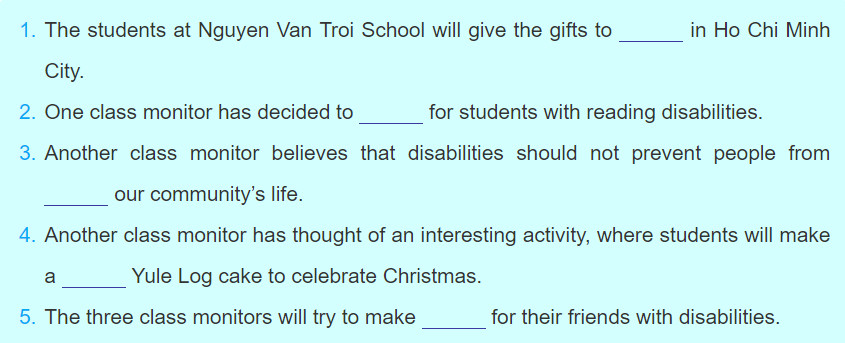
Guide to answer
1. students with disabilities
2. record popular books
3. participating fully in
4. "record-breaking"
5. this Christmas unforgettable
Tạm dịch:
1. Sinh viên trường Nguyễn Văn Trỗi sẽ tặng quà cho học sinh khuyết tật tại thành phố Hồ Chí Minh.
2. Một lớp học giám sát đã quyết định ghi lại sách phổ biến cho học sinh bị khuyết tật về đọc sách.
3. Một giám sát viên lớp khác tin rằng không nên ngăn cản những người khuyết tật tham gia đầy đủ vào cuộc sống của cộng đồng chúng ta.
4. Một người theo dõi lớp học đã nghĩ đến một hoạt động thú vị, nơi sinh viên sẽ tạo ra một chiếc bánh kem Yule Log để kỷ niệm Giáng sinh.
5. Ba lớp trưởng lớp học sẽ cố gắng làm cho Giáng sinh này không thể nào quên cho bạn bè khuyết tật của họ.
5. Task 5 Unit 4 lớp 11 Reading
Discuss with a partner how can help children with disabilities in your community. (Thảo luận với bạn bên cạnh về cách giúp trẻ em khuyết tật trong cộng đồng bạn ở.)
Guide to answer
There are a lot of things you can do to help disabled children in your community. Firstly, make sure you use the right terms when discussing children with disabilities. For example, do not say "mentally ill person" or "the mentally ill." Instead say, "person who has a mental illness." Secondly, communicate directly. Oftentimes, children with disabilities are assisted by interpreters, nurses, or friends during their day-to-day lives. Do not filter conversation through someone else. Thirdly, ask before providing assistance. If you see a child with a disability struggling with something, your first instinct may be to jump in and help. However, without knowing that child's specific needs or intentions you may be doing more harm than good. Finally, raise or donate money. Sometimes, fundraising is very helpful. Children with disabilities often need extra funds to cover medical costs, home renovations, and other expenses.
Tạm dịch
Có rất nhiều điều bạn có thể làm để giúp đỡ trẻ em khuyết tật trong cộng đồng của bạn. Thứ nhất, đảm bảo bạn sử dụng các thuật ngữ đúng khi thảo luận về trẻ em khuyết tật. Ví dụ: không nói "người bị bệnh tâm thần" hoặc "người bị bệnh tâm thần". Thay vào đó hãy nói, "người mắc bệnh tâm thần." Thứ hai, giao tiếp trực tiếp. Thông thường, trẻ em khuyết tật được hỗ trợ bởi thông dịch viên, y tá hoặc bạn bè trong cuộc sống hàng ngày của họ. Đừng lọc cuộc trò chuyện thông qua người khác. Thứ ba, hỏi trước khi cung cấp hỗ trợ. Nếu bạn thấy một đứa trẻ khuyết tật đang vật lộn với điều gì đó, bản năng đầu tiên của bạn có thể là nhảy vào và giúp đỡ. Tuy nhiên, không biết rằng nhu cầu hoặc ý định cụ thể của trẻ em, bạn có thể gây hại nhiều hơn là tốt. Cuối cùng, quyên góp hoặc quyên góp tiền. Đôi khi, gây quỹ là rất hữu ích. Trẻ em khuyết tật thường cần thêm tiền để trang trải chi phí y tế, cải tạo nhà và các chi phí khác.
6. Practice
6.1. Reading comprehension
Read the following passage and mark the letter A, B, C, or D on your answer sheet to indicate the correct answer to each of the questions
Earth is richly supplied with different types of living organisms which co-exist in their environments, forming complex, interrelated communities. Living organisms depend on one another for nutrients, shelter, and other benefits. The extinction of one species can set off a chain reaction that affects many other species, particularly if the loss occurs near the bottom of the food chain. For example, the extinction of a particular insect or plant might seem inconsequential. However, there may be fish or small animals that depend on that resource for foodstuffs. The loss can threaten the survival of these creatures and larger predators that prey upon them. Extinction can have a ripple effect that spreads throughout nature.
In addition to its biological consequences, extinction poses a moral dilemma for humans, the only species capable of saving the others. The presence of humans on the planet has affected all other life forms, particularly plants and animals. Human lifestyles have proven to be incompatible with the survival of some other species. Purposeful efforts have been made to eliminate animals that prey on people, livestock, crops, or pose any threat to human livelihoods. Some wild animals have been decimated by human desire for meat, hides, fur, or other body parts with commercial value. Likewise, demand for land, water, and other natural resources has left many wild plants and animals with little to no suitable habitat. Humans have also affected nature by introducing non-native species to local areas and producing pollutants having a negative impact on the environment. The combination of these human-related effects and natural obstacles such as disease or low birthrates has proven to be too much for some species to overcome. They have no chance of survival without human help.
As a result, societies have difficult choices to make about the amount of effort and money they are willing to spend to save imperiled species. Will people accept limits on their property rights, recreational activities, and means of livelihood to save a plant or an animal? Should saving such popular species as whales and dolphins take priority over saving obscure, annoying, or fearful species? Is it the responsibility of humans to save every kind of life form from disappearing, or is extinction an inevitable part of nature, in which the strong survive and the weak perish? These are some difficult questions that people face as they ponder the fate of other species living on this planet.
Question 1: What does the passage mainly discuss?
A. Humans and endangered species B. The importance of living organisms
C. Measures to protect endangered species D. Causes of animal extinction
Question 2: The word "inconsequential" in paragraph 1 is closest in meaning to ______.
A. unimportant B. unavoidable C. unexpected D. unrecognizable
Question 3: Which of the following can result from the loss of one species in a food chain?
A. The connections among the creatures in the food chain become closer.
B. Larger predators will look for other types of prey.
C. There might be a lack of food resources for some other species.
D. Animals will shift to another food chain in the community.
Question 4: The word "They" in paragraph 2 refers to ______.
A. human-related effects B. some species
C. low birthrates D. natural obstacles
Question 5: In paragraph 2, non-native species are mentioned as ______.
A. a kind of harmless animals B. an achievement of human beings
C. a harmful factor to the environment D. a kind of useful plants
Question 6: The word "perish" in paragraph 3 is closest in meaning to ______.
A. develop B. complete C. remain D. disappear
Question 7: According to the passage, which of the following statements is NOT true?
A. Humans have difficult choices to make about saving endangered species.
B. The existence of humans is at the expense of some other species.
C. No other species can threaten the survival of humans on Earth.
D. Some animals and plants cannot survive without human help.
Question 8: Which of the following can be inferred from the passage?
A. Animal and plant species which pose threats to humans will die out soon.
B. Saving popular animal and plant species should be given a high priority.
C. Humans will make changes in their lifestyles to save other species
D. The dilemma humans face between maintaining their lives and saving other species remains
6.2. Multiple-choice
Để rèn luyện kĩ năng đọc hiểu và có cái nhìn chi tiết về chủ đề bài học, mời các em đến với đề kiểm tra trắc nghiệm Unit 4 Reading Tiếng Anh 11 mới và cùng luyện tập.
7. Conclusion
Kết thúc bài học, các em cần làm bài tập đầy đủ và luyện tập đọc hiểu, trả lời câu hỏi; đồng thời ghi nhớ các từ vựng:
- energetic - năng nổ, tràn trề năng lượng
- enthusiastically - một cách nhiệt tình
- slogan - khẩu hiệu
- involve - lôi kéo, khiến ai đó tham gia vào...
- support - hỗ trợ
Tham khảo thêm
- doc Unit 4 lớp 11: Caring For Those In Need - Getting Started
- doc Unit 4 lớp 11: Caring For Those In Need - Language
- doc Unit 4 lớp 11: Caring For Those In Need - Speaking
- doc Unit 4 lớp 11: Caring For Those In Need - Listening
- doc Unit 4 lớp 11: Caring For Those In Need - Writing
- doc Unit 4 lớp 11: Caring For Those In Need - Communication and Culture
- doc Unit 4 lớp 11: Caring For Those In Need - Looking Back
- doc Unit 4 lớp 11: Caring For Those In Need - Project



